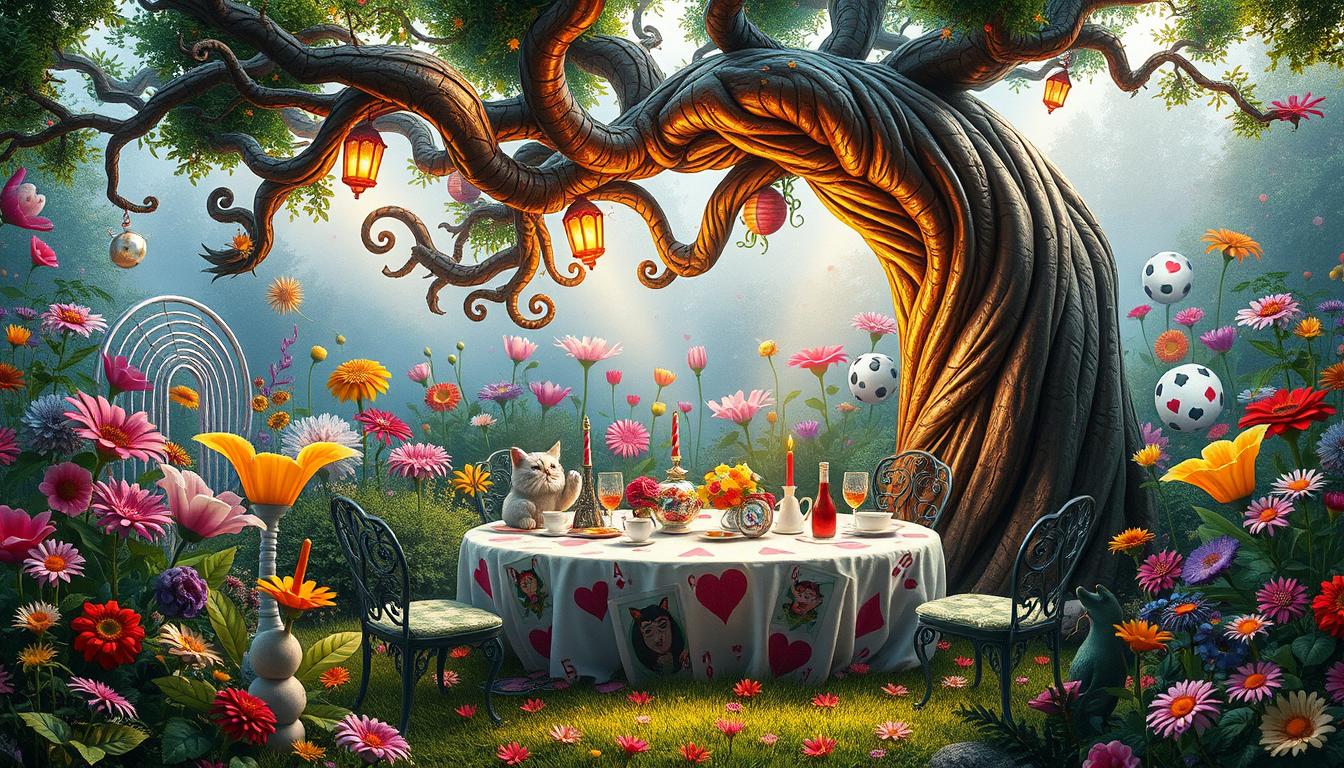Imagine falling down a rabbit hole and entering a world where logic is twisted, and imagination knows no bounds. This is the world of Alice’s Adventures in Wonderland, a fantasy novel written by Lewis Carroll that has captivated readers for over 150 years. First published in 1865, this beloved British children’s book has become one of the most popular works of English-language fiction, with its unique blend of imagination, logic, and surreal elements.
At the heart of this timeless classic is the story of a young girl’s adventures in a fantastical world, filled with strange creatures, riddles, and puzzles. Lewis Carroll’s masterpiece has undergone many adaptations, including films, theatrical performances, and ballets, showcasing its enduring popularity and cultural impact. As we delve into the world of Alice’s Adventures in Wonderland, we’ll explore the book’s significance as a fantasy novel and its ability to inspire imagination and creativity in readers of all ages.
Key Takeaways
- Alice’s Adventures in Wonderland is a fantasy novel written by Lewis Carroll, first published in 1865.
- The book has become one of the most beloved works of English-language fiction, with its unique blend of imagination, logic, and surreal elements.
- Lewis Carroll’s masterpiece has undergone many adaptations, including films, theatrical performances, and ballets.
- The book explores themes of identity, reality, and the nature of language, making it a significant work in children’s literature.
- Alice’s Adventures in Wonderland has inspired imagination and creativity in readers of all ages, making it a timeless classic.
- The book’s enduring popularity is a testament to the power of imagination and the human desire to explore new and fantastical worlds.
Introduction to Alice’s Adventures in Wonderland
Alice’s Adventures in Wonderland is a timeless tale that has captivated readers of all ages with its unique blend of children’s literature and fantastical elements. The story centers around Alice, a young girl who falls asleep in a meadow and dreams that she follows the White Rabbit down a rabbit hole, entering a world of wonder and curiosity.
The novel’s enduring popularity can be attributed to its ability to spark imagination and creativity in readers. With its richly detailed world and memorable characters, Alice’s Adventures in Wonderland has become a staple of children’s literature, inspiring countless adaptations and interpretations. The story’s themes of growth, identity, and the power of imagination continue to resonate with readers today.
The story’s author, Lewis Carroll, was a master of weaving complex ideas and themes into a narrative that is both entertaining and thought-provoking. His use of illogical and strange creatures, such as the White Rabbit, adds to the story’s sense of wonder and enchantment. As a key figure in the development of children’s literature, Carroll’s work continues to influence writers and artists to this day.
Some notable facts about Alice’s Adventures in Wonderland include:
- The book has been translated into 174 languages, showcasing its widespread international appeal.
- The original manuscript of Alice’s Adventures Under Ground is held in the British Library, preserving the primary version of the story.
- The published version of Alice’s Adventures in Wonderland is approximately twice the length of the original Alice’s Adventures Under Ground, with added episodes like the Mad Hatter’s Tea-Party.
The Journey Begins: Alice Falling Down the Rabbit Hole
Alice’s adventure in the fantasy novel begins with her falling down the rabbit hole, a symbol of transition from the familiar to the unknown. The White Rabbit, with his frantic pace and concern for time, sets the tone for Alice’s journey. As she falls, Alice contemplates the potential distance she has traveled, estimating around four thousand miles before stopping at the bottom.
The rabbit hole serves as a gateway to a fantastical world, where Alice encounters various surreal and nonsensical elements. Her curiosity and desire for discovery drive the narrative forward, as she navigates this new world and meets its inhabitants. The story of Alice’s adventures has evolved from a simple tale told to the Liddell children into a beloved fantasy novel, with the White Rabbit remaining an iconic character.
- Encountering the tiny door behind the curtain, about fifteen inches high
- Drinking from the bottle labeled “DRINK ME”, which contains a mixture of flavors
- Attending the trial of the Knave of Hearts, accused of stealing tarts
These elements contribute to the rich and imaginative world of the fantasy novel, making it a timeless classic.
Characters That Captivate: A Dive into Wonderland’s Inhabitants
The story of Alice’s Adventures in Wonderland is filled with a variety of unique and captivating characters. One of the most iconic characters is the Mad Hatter, known for his eccentric behavior and love of tea parties. The Mad Hatter’s tea party scene is a highlight of the story, showcasing his quirky personality and the absurdity of Wonderland.
Another notable character is the Queen of Hearts, who rules Wonderland with an iron fist. Her chaotic and unpredictable nature makes her a fascinating character to explore. The Cheshire Cat is also a beloved character, known for his mischievous grin and ability to disappear and reappear at will.
These characters, along with others, contribute to the surreal and whimsical atmosphere of Wonderland. They each bring their own unique personality and quirks to the story, making it a fascinating and engaging read.
- The Mad Hatter’s love of tea parties and his eccentric behavior
- The Queen of Hearts’ chaotic and unpredictable nature
- The Cheshire Cat’s mischievous grin and ability to disappear and reappear
| Character | Description |
|---|---|
| Mad Hatter | Eccentric and loves tea parties |
| Queen of Hearts | Chaotic and unpredictable |
| Cheshire Cat | Mischievous and can disappear and reappear |
Lewis Carroll’s Unique Writing Style
Lewis Carroll’s narrative style is engaging, filled with humor, wit, and a sense of whimsy that makes the book a delightful read. His use of language is playful and inventive, with puns, parodies, and linguistic puzzles that add depth to the story. For example, in his famous nonsense poem Jabberwocky, Carroll showcases his mastery of language and wordplay.
Carroll’s writing style is characterized by his use of nonsense and absurdity, which contributes to the story’s charm and appeal. His background in mathematics and logic is also evident in his writing, with elements of logic and puzzle-solving appearing throughout the story. Approximately 20% of the book is composed of songs and poems, which adds to the story’s unique charm.
- Playful language and wordplay
- Use of nonsense and absurdity
- Influence of poetry on prose, as seen in Jabberwocky
These elements combine to create a unique and captivating writing style that has made Lewis Carroll’s work enduringly popular.
| Feature | Description |
|---|---|
| Playful language | Use of puns, parodies, and linguistic puzzles |
| Nonsense and absurdity | Elements that contribute to the story’s charm and appeal |
| Poetic influence | Seen in works like Jabberwocky, which showcases Carroll’s mastery of language and wordplay |
Themes of Identity and Growth
Alice’s journey in Alice’s Adventures in Wonderland can be seen as a metaphor for the transition from childhood to adulthood, a period marked by confusion, change, and the struggle to make sense of the world. This classic example of Children’s literature explores the deeper themes of identity and growth, challenging readers to think critically about the concept of self.
As Alice navigates through Wonderland, she experiences physical changes that symbolize her growth and development. These transformations serve as a reminder that identity is not fixed, but rather it evolves over time. The story highlights the importance of curiosity and exploration in shaping one’s sense of self, as Alice’s adventures in Wonderland prompt her to question her own identity and place in the world.
The themes of identity and growth in Alice’s Adventures in Wonderland are timeless and universal, resonating with readers of all ages. As a work of Children’s literature, the story has a unique ability to capture the imagination and spark important discussions about the nature of self and the world around us. Through Alice’s experiences, Lewis Carroll invites readers to reflect on their own journey of growth and self-discovery, making Alice’s Adventures in Wonderland a beloved and enduring classic in the world of literature.
The Concept of Self in Wonderland
In Wonderland, the concept of self is constantly challenged and subverted, as Alice encounters strange creatures and experiences that force her to re-evaluate her own identity. This process of self-discovery is a key aspect of the story, as Alice learns to navigate the complexities of her own sense of self and find her place in the world.
The Role of Growing Up and Change
Through Alice’s adventures in Wonderland, Lewis Carroll explores the role of growing up and change in shaping one’s sense of identity. The story highlights the importance of embracing change and being open to new experiences, as Alice’s journey is marked by a series of transformations and challenges that ultimately lead to her growth and development.
The Surreal Elements of Wonderland
In the realm of fantasy novels, few stories have captivated readers like Alice’s Adventures in Wonderland. The Mad Hatter, with his eccentric tea parties, is a prime example of the surreal elements that make this tale so enduring. From shrinking and growing in size to encountering a grinning Cheshire Cat that fades in and out of existence, Alice’s journey is filled with surreal experiences that defy reason but reflect the boundless creativity of the human mind.
The concept of dream logic and the nature of reality in Wonderland is a fascinating aspect of the story. Lewis Carroll’s use of illogical events and surreal characters, such as the Mad Hatter, creates a sense of wonder and curiosity in the reader. The role of time in the story, particularly in relation to the Mad Hatter’s tea party, where time has stopped, adds to the surreal atmosphere of Wonderland.
- Dream logic and the nature of reality
- The role of time in the story
- Surreal characters, such as the Mad Hatter and the Cheshire Cat
These elements contribute to the story’s themes and overall impact, reflecting on how they mirror the often confusing and illogical nature of the real world as seen through a child’s eyes.
In conclusion, the surreal elements of Wonderland, as seen in fantasy novels like Alice’s Adventures in Wonderland, are a key part of the story’s enduring appeal. The Mad Hatter’s tea party, with its illogical and fantastical elements, is just one example of the many surreal experiences that make this tale so memorable.
| Element | Description |
|---|---|
| Dream Logic | The concept of dream logic and the nature of reality in Wonderland |
| Time | The role of time in the story, particularly in relation to the Mad Hatter’s tea party |
| Surreal Characters | The Mad Hatter and the Cheshire Cat, among others |
Symbolism and Motifs in the Narrative
The story of Alice’s Adventures in Wonderland is rich in symbolism and motifs, with the Queen of Hearts and the Cheshire Cat being two of the most prominent symbols. The Queen of Hearts represents fear and authority, reflecting the tyrannical rule and punitive nature commonly associated with Victorian societal structures. In contrast, the Cheshire Cat symbolizes a wise and enigmatic guide for Alice, offering riddles that push her towards understanding the madness of Wonderland.
Some of the key motifs in the narrative include:
- Cards and games, which reflect the rules and structure of Victorian society
- The Cheshire Cat’s mysterious smile, which represents the duality of Wonderland
- The Mock Turtle’s bizarre education, which highlights the absurdity of the adult world
These motifs and symbols contribute to the story’s themes of self-discovery, imagination, and the transition from childhood to adulthood. The use of symbolism in the narrative serves to convey deeper meanings related to individuality, creativity, and the challenges of societal norms.
The Cheshire Cat’s role as a guide and confidant to Alice is particularly significant, as it represents the idea that even in the most confusing and illogical of worlds, there is always a way to find one’s path. The Queen of Hearts, on the other hand, serves as a reminder of the dangers of unchecked power and the importance of empathy and compassion.
| Symbol | Meaning |
|---|---|
| Queen of Hearts | Fear and authority |
| Cheshire Cat | Mystery and duality |
The Role of Logic and Absurdity
Lewis Carroll’s work, particularly in “Alice’s Adventures in Wonderland,” showcases a unique blend of logic and absurdity. As a mathematician, Carroll infused the novel with rational thought, only to lead it to nonsensical conclusions. This blend is evident in the character of Alice, who attempts to apply real-world logic to the whimsical world of Wonderland, often resulting in absurd outcomes.
The concept of logic and absurdity is further explored through the use of puzzles and riddles in the story. These puzzles serve as a reflection of life, where the lines between sense and nonsense are often blurred. Carroll’s use of nonsense as a vehicle for creativity and humor challenges traditional rules of language and politeness, making the story a commentary on the nature of reality and meaning.
In the context of Lewis Carroll’s work, the poem “Jabberwocky” is a prime example of this blend of logic and absurdity. The use of made-up words and phrases creates a sense of nonsense, while the structure and rhythm of the poem follow a logical pattern. This juxtaposition of rationality and absurdity adds depth to the narrative, making it a thought-provoking and engaging read.
Some key aspects of Carroll’s use of logic and absurdity include:
- The use of paradoxes and contradictions to challenge traditional notions of reality
- The employment of wordplay and nonsense to create a sense of wonder and curiosity
- The exploration of the relationship between language and meaning, highlighting the complexities of communication
Overall, the role of logic and absurdity in Lewis Carroll’s work is a testament to the power of creativity and imagination. By blending rational thought with nonsense, Carroll creates a unique and captivating narrative that continues to inspire and intrigue readers to this day.
The Impact of Alice’s Adventures on Popular Culture
Alice’s Adventures in Wonderland has had a profound impact on popular culture, inspiring numerous adaptations and references in film, television, literature, and art. The Fantasy novel has been reimagined in various forms, from Walt Disney’s 1951 animated film to Tim Burton’s 2010 live-action adaptation, introducing the story to new generations of audiences.
The influence of Alice’s Adventures in Wonderland can be seen in many aspects of popular culture, with approximately 60 literary retellings and over 40 film adaptations of the original tale. The story’s themes, characters, and imagery have become deeply ingrained in our cultural consciousness, making it a true cultural phenomenon.
Some notable examples of the story’s impact include:
- Over 30 stage adaptations of Alice’s Adventures in Wonderland have been produced.
- A statue of Alice and other characters was placed in New York City’s Central Park in 1959.
- Llandudno features a sculpture trail of Alice in Wonderland characters in Wales.
The story’s enduring popularity is a testament to the power of Alice’s Adventures in Wonderland to inspire and captivate audiences, and its influence can be seen in many aspects of popular culture, from film and literature to art and music.
Educational Value of the Story
Lewis Carroll’s “Alice’s Adventures in Wonderland” has been a cornerstone of children’s literature for over a century, offering a unique blend of imagination, logic, and surreal wonder. Unlike much of the children’s literature of its time, which focused on teaching moral lessons, Carroll’s work prioritizes imagination and creativity. This approach has made the story a valuable educational tool, fostering a love of literature and encouraging critical thinking skills in generation after generation of readers.
One of the key lessons that can be derived from the story is the importance of imagination. As Alice navigates the fantastical world of Wonderland, she must use her imagination to make sense of the strange and illogical events that unfold around her. This emphasis on imagination has made the story a staple of children’s literature, inspiring young readers to think creatively and explore the boundaries of their own imagination.
Some of the valuable lessons that can be learned from “Alice’s Adventures in Wonderland” include:
- Embracing curiosity and adventure
- Building meaningful friendships
- Facing fears and overcoming them through strength and resilience
- Learning from mistakes and embracing personal growth
- Accepting differences in oneself and others
These lessons, among others, have made “Alice’s Adventures in Wonderland” a timeless classic, continuing to inspire and educate readers of all ages. With its unique blend of imagination, logic, and surreal wonder, the story remains a vital part of children’s literature, offering a wealth of educational value and inspiration for young readers.
Lewis Carroll’s work has had a lasting impact on the world of children’s literature, and his story continues to be a beloved and educational part of many children’s lives. As a testament to its enduring popularity, over 40 cinematic adaptations of “Alice’s Adventures in Wonderland” have been made since the original publication in 1865.
| Lesson | Description |
|---|---|
| Importance of Imagination | Encourages creative thinking and exploration |
| Embracing Curiosity and Adventure | Fosters a sense of wonder and openness to new experiences |
| Building Meaningful Friendships | Highlights the value of relationships and social connections |
Conclusion: The Enduring Legacy of Alice’s Adventures
Alice’s Adventures in Wonderland remains one of the most beloved and enduring works of children’s literature. Its playful narrative, whimsical characters, and exploration of profound themes make it a book that continues to captivate readers of all ages. The Fantasy novel has been a staple of many childhoods, and its influence can be seen in numerous adaptations and interpretations.
The story’s ability to resonate with readers of all ages is a testament to its timeless appeal. With over twenty-five film and theater iterations, as well as numerous literary adaptations, Alice’s Adventures in Wonderland has become a cultural touchstone. The novel’s enduring legacy has led to it being ranked number four in BBC Culture’s list of the top eleven children’s books.
Why the Story Continues to Resonate
The story’s themes of identity, growth, and the nature of reality remain relevant in our modern world. The Fantasy novel has inspired many writers, including J.K. Rowling, Neil Gaiman, and L. Frank Baum, who have drawn inspiration from Alice’s Adventures in Wonderland for their own fantastical worlds. The novel’s influence can be seen in many aspects of popular culture, from film and literature to art and music.
Some notable adaptations and interpretations of Alice’s Adventures in Wonderland include:
- The 1951 Walt Disney animated film adaptation
- Tim Burton’s 2010 live-action film adaptation
- Literary adaptations by authors such as J.K. Rowling and Neil Gaiman
Final Thoughts on Imagination and Playfulness
In conclusion, Alice’s Adventures in Wonderland is a timeless classic that continues to delight and challenge readers around the world. The novel’s enduring legacy is a testament to the power of imagination and playfulness in literature and in life. As a Fantasy novel, it has inspired countless adaptations and interpretations, and its influence can be seen in many aspects of popular culture.
| Year | Adaptation | Medium |
|---|---|---|
| 1951 | Walt Disney animated film | Film |
| 2010 | Tim Burton live-action film | Film |
| 1865 | Original novel publication | Literature |
Additional Resources for Further Exploration
For readers eager to delve deeper into the captivating world of “Alice’s Adventures in Wonderland” and the life of its renowned author, Lewis Carroll, there are a wealth of resources available. Biographies and scholarly works offer fascinating insights into Carroll’s complex personality and the inspirations behind his timeless classic.
Recommended Readings About Lewis Carroll
The British Library’s extensive collection on Lewis Carroll provides a treasure trove of information, including personal letters, original manuscripts, and critical analysis of his writings. We also recommend exploring “Exploring the Psychology of Wonderland,” a scholarly work that examines the psychological depth and symbolism woven throughout the story.
Online Communities and Discussion Groups
Fans of “Alice’s Adventures in Wonderland” can find vibrant online communities where they can engage with fellow enthusiasts, share interpretations, and discover new perspectives on the story. These discussion groups offer a platform to explore the enduring legacy of Lewis Carroll and the Alice narrative, delving into the nuances of its captivating characters and the timeless themes that continue to resonate with readers worldwide.














